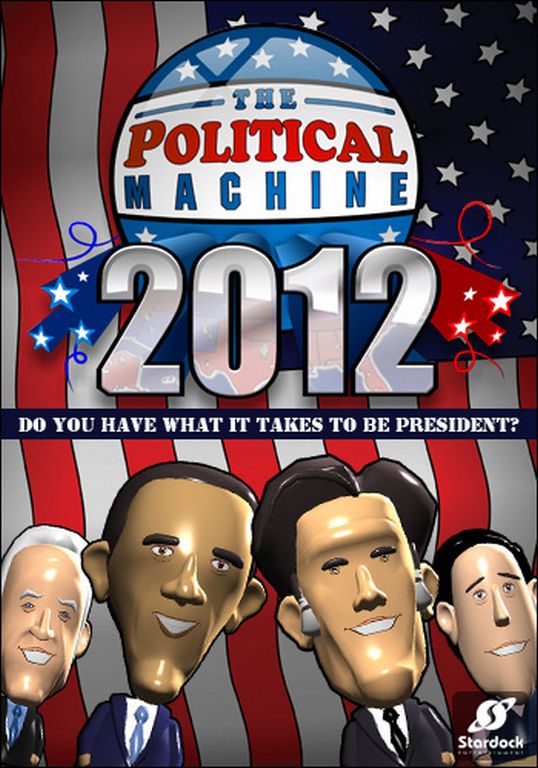
I live in a democracy which, even if it’s not built on the same core concepts, shares much when it comes to procedures, concepts and ideas with the United States of America and that makes The Political Machine 2012, the political strategy game from Stardock, both fascinating and, at times, frustrating.
It manages to model, in mostly interesting ways, the mechanics of the popular vote and the way the Electoral College needs to be taken into account by candidates coming from both the Republican and the Democratic parties.
I played The Political Machine 2012 long enough to win with Obama, Romney, a robot candidate that I designed to resemble Skynet, a uber-Democrat and even Sarah Palin, so it’s clear that the game is interesting and varied enough to cater to a variety of political options and strategies.
Gameplay
The first and maybe most important step in playing The Political Machine 2012 is to decide who you plan on trying to take to the Presidency of the United States and who will be the opponent you face.
The game offers a wide selection of well-known politicians from both major political parties in the United States, the Democrats and the Republicans, but it’s even more interesting to design your own candidate.
 |  |
Gamers can then spend a limited number of points in order to define everything from how charismatic to how good he is at gathering and spending money. They can then set his position when it comes to a number of hot button current political subjects, ranging from a possible strike against Iran to their attitude to Obamacare.
The results can be very interesting and they have a clear impact when it comes to the actual game, so be careful about courting the gun lobby too much or about showing no interest in the rights of minorities.
The only flaw in the design system is that it does not accept actual third-party candidates, which gives The Political Machine 2012 focus. Yet, it can frustrate those who were looking to see whether a Ralph Nader or Green Party candidate had a shot at the Presidency.
Once a candidate is created or chosen, his opponent must also be defined via selection or customization and then the actual campaign starts.
Candidates can perform a variety of actions each week, based on their energy level, from creating HQ structures (which can generate money, operatives or endorsement points) to giving speeches, implementing media campaigns or simply asking money for funds.
At one point, a vice president needs to be selected and there are media interviews to conduct (with some pretty decent humor when it comes to the spoof questions and answers) and incidents to deal with.
The speeches and media messages need to be suited to the state where they’re given, and as the campaign progresses, the issues change and a good candidate needs to make sure that he gains exposure and support while also making things difficult for his opponent.
After an initial period when positions are presented and a general strategy is penciled in, The Political Machine 2012 becomes a mud fight in the final weeks of the campaign as closely contested states are frequently visited and each small advantage is ruthlessly exploited.
One big problem with The Political Machine 2012 is that it does not factor in the recent Citizens United decision from the Supreme Court, which has opened up the flow of money from so-called Super PACs and which has changed the way candidates and parties get the money they need in order to run campaigns.
After seeing the totals that Barrack Obama and Mitt Romney are racking up in the real world, most of the sums (especially for the Republican challenger) coming from big donors, the paltry millions in The Political Machine 2012 seem like an inadequate simulation.
Other than that, the mechanics of presidential campaigns, as the public knows them from media reports, are well simulated and interesting, and the final rush to get the all-important votes from California, Florida and Texas is always exciting.
The team has also managed to balance the political situation in the game very well, with issues like the economy and social security, which are set to dominate the real-world election, also the most interesting ones to the citizens in The Political Machine 2012.
Graphics and audio
The very nature of The Political Machine 2012 means that the game does not need to have a solid graphics engine behind it.
A lot of the work was concentrated on style and on humor, and here the development team manages to create a good solid interface and an overall look that manages to deliver information to the player without asking him to go deep through layers of screens.
The Political Machine 2012 uses red and blue as the primary colors and that might be a little tiring in the long term, but it’s not an immediate problem as long as the player doesn’t actually have a strong reaction to the trademark look of the Republicans and the Democrats.
 |  |
The disappointing fact is that there’s virtually no change from the previous version of the game, which was launched in 2008, and that’s a problem in the graphics and sound department that reflects deeper issues with the gameplay of the political game.
When it comes to the sound department, The Political Machine 2012 is suitably equipped with the cheers, the jeers and the applause that’s the constant backdrop of the modern political landscape. Yet, the music itself is repetitive and quickly moves towards annoying territory.
Multiplayer
To play the multiplayer side of The Political Machine 2012, the player needs to create a Stardock account, but the process is simpler than that involved with similar solutions like Origin from Electronic Arts or Uplay from Ubisoft.
Sometimes human players feel a little weird and I must say that I prefer to play the game against the computer rather than against my fellow players.
Conclusion
The problem with a game like The Political Machine 2012 is that it might fail to capture a clear audience, as hardcore political watchers consider it as being too simple while the more casual voters might have problems understanding some of the mechanics.
But Stardock has done a great job of creating a game that digs up some of the mechanisms of democracy and elections, using them to encourage players to think about real-world issues and maybe question their own options and ideas.
Playing the game I could not avoid wondering things like: why shadowy, unnamed political operatives are so powerful? Why do only issues that candidates mention in speeches get pushed by the media? Why does the Electoral College have such a big influence on United States Presidential elections?
The Political Machine 2012 manages to be somewhat rather unique in the gaming world: a fun turn-based strategy game that takes a real-world situation and makes it both fun and intriguing, with some solid design decisions and an interesting overall style.
 |  |  |  |  |  |
 |  |  |  |  |  |
 |  |  |  |  |  |
Via: The Political Machine 2012 Review (PC)
Tidak ada komentar:
Posting Komentar